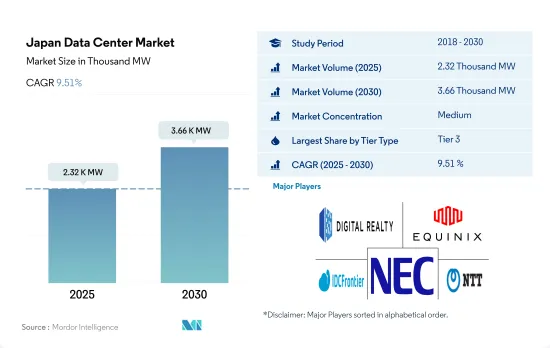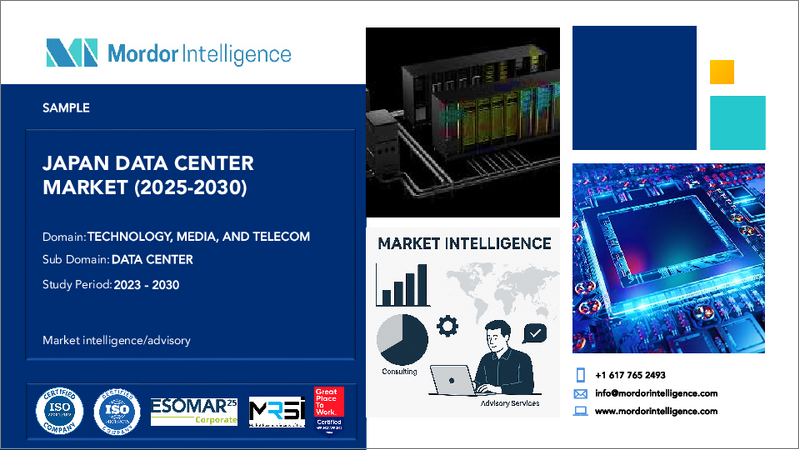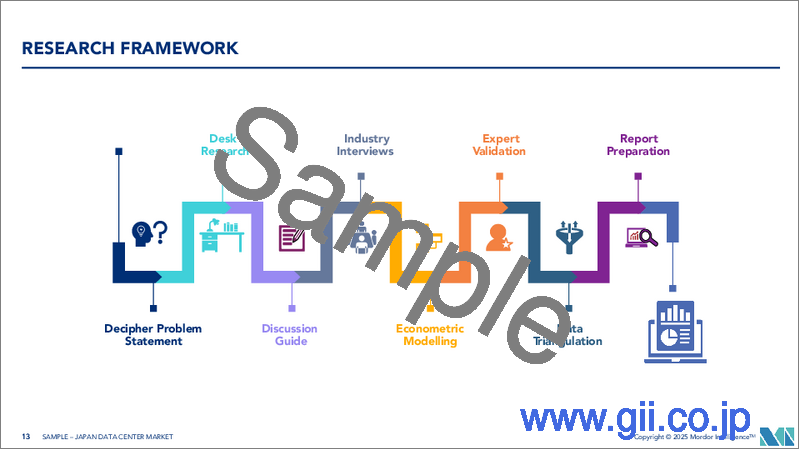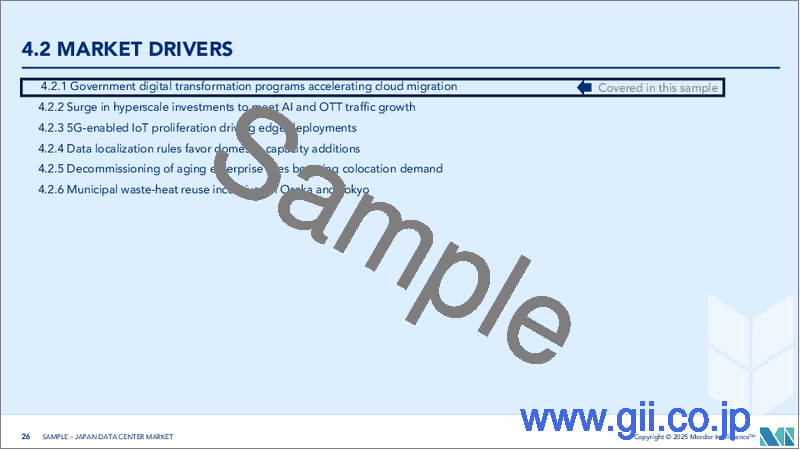|
|
市場調査レポート
商品コード
1690741
日本のデータセンター:市場シェア分析、産業動向、成長予測(2025年~2030年)Japan Data Center - Market Share Analysis, Industry Trends & Statistics, Growth Forecasts (2025 - 2030) |
||||||
カスタマイズ可能
適宜更新あり
|
|||||||
| 日本のデータセンター:市場シェア分析、産業動向、成長予測(2025年~2030年) |
|
出版日: 2025年03月18日
発行: Mordor Intelligence
ページ情報: 英文 195 Pages
納期: 2~3営業日
|
全表示
- 概要
- 目次
日本のデータセンター市場規模は、2025年に2,320MW、2030年には3,660MWに達すると推定され、CAGR 9.51%で成長すると予測されます。
また、2025年には25億1,150万米ドルのコロケーション収益が見込まれ、2030年には49億8,150万米ドルに達すると予測され、予測期間(2025~2030年)のCAGRは14.68%です。

2023年にはティア3データセンターが数量ベースで大半のシェアを占めるが、予測期間を通じてティア4が最も急成長しています。
- ティア3データセンターは、はるかに優れた冗長保護機能を提供するため、主にSMB(中小企業)に好まれています。ティア2からアップタイムが大幅に向上し、ティア3では年間99.982%のアップタイムが提供されます。このセグメントは、2022年の1,309.25MWから2029年には1,905.47MWに成長し、CAGR 5.51%を記録すると予想されています。これらのデータセンターは主に大企業に選ばれています。
- ティア4施設は、そのパフォーマンス、ダウンタイムの少なさ、99.99%のアップタイムにより、大企業が次に好むデータセンターです。しかし、大多数の施設は、長期的な財務と運用の持続可能性から、依然としてティア3データセンターを好んでいます。ティア3は、産業全体で最も広く採用されている標準です。しかし、ティア4施設の成長率が最も大きくなると予想されます。
- ティア1とティア2のデータセンターは、ダウンタイムが長く、冗長性が低いため、最も好まれないが、新興企業は通常これらのデータセンターを好みます。しかし、日本では新興企業もティア3のデータセンターを好みます。現在、日本ではティア1とティア2に認定された施設はなく、この傾向は予測期間中も続くと予想されます。
日本のデータセンターの動向
スマートフォン普及率の上昇と新たなeコマースプラットフォームの出現が市場を牽引
- 日本のスマートフォンユーザー数は、2022年には1億710万人に達しました。予測期間中のCAGRは1.3%で、2029年には1億1,777万人に達すると予測されます。
- 2021年には、日本の世帯におけるスマートフォン普及率は89%に近づいた。モバイルインターネットの平均利用時間は近年増加しており、eコマースなどの関連産業にビジネス機会をもたらしています。
- オンラインショッピングプラットフォームの出現により、中小企業もオンライン決済やeコマースの世界でのデジタルプレゼンスに切り替えつつあります。大企業や老舗企業も、eコマースプラットフォームと従来のビジネス形態を併用しています。例えば、2022年4月、東京を拠点とする塩ビ産業向け特殊安定剤の大手サプライヤーであるウェストレイク昭島は、新しいeコマースプラットフォームを発表し、安全性と利便性を備えたオンライン購入体験をバイヤーに拡大しました。このような開発はeコマースとオンライン決済のエコシステムを形成し、日本のモバイル決済に影響を与えています。
大手携帯電話事業者による5G展開の拡大と同セグメントにおける政府の支援がデータセンター市場を牽引します。
- 日本政府は2019年4月、NTTDocomo、KDDI au、SoftBankの携帯電話事業者3社と、新たに参入した楽天モバイルに5G周波数を割り当てました。今後数年間で、日本の通信事業者4社は5Gネットワークを構築するために、基地局、サーバー、光ファイバーへの投資を含む設備投資に140億米ドル以上を費やすと予想されています。
- 2021年の開始以来、日本の携帯通信事業者は5Gの展開を加速させています。SoftBankは2022年3月末までに5万以上の5G基地局を配備し、人口カバー率90%を目指します。KDDIauは2021年3月に1万局だった基地局を1年後には5万局に増やすことを目指しています。NTTDocomoは2021年中に5Gネットワークを拡大し、6月までに1万基地局、2022年3月末までに2万基地局、新しい高速5G周波数帯を使用して人口カバー率55%を目指します。
- 総務省は、日本の5G体験を引き続き前進させることを目指しています。2024年3月末までに5G人口カバー率98%という目標を掲げています。日本は全体として、5Gサービスに利用可能な周波数帯を増やすことを目指しています。
日本のデータセンター産業概要
日本のデータセンター市場は適度に統合されており、上位5社で41.74%を占めています。この市場の主要企業は、 Digital Realty Trust Inc., Equinix Inc., IDC Frontier Inc.(SoftBank Group), NEC Corporation and NTT Ltd
その他の特典
- エクセル形式の市場予測(ME)シート
- 3ヶ月間のアナリストサポート
目次
第1章 エグゼクティブサマリーと主要調査結果
第2章 レポートのオファー
第3章 イントロダクション
- 調査の前提条件と市場定義
- 調査範囲
- 調査手法
第4章 市場展望
- 耐荷重
- 床面積
- コロケーション収入
- 設置ラック数
- ラックスペース利用率
- 海底ケーブル
第5章 主要産業動向
- スマートフォンユーザー数
- スマートフォン1台当たりのデータトラフィック
- モバイルデータ速度
- ブロードバンドデータ速度
- 光ファイバー接続ネットワーク
- 規制の枠組み
- 日本
- バリューチェーンと流通チャネル分析
第6章 市場セグメンテーション
- ホットスポット
- 大阪
- 東京
- その他の中東・アフリカ
- データセンターの規模
- 大規模
- 超大規模
- 中規模
- 極超大規模
- 小規模
- ティアタイプ
- ティア1と2
- ティア3
- ティア4
- 吸収量
- 非利用
- 利用
- コロケーションタイプ別
- ハイパースケール
- 小売
- 卸売
- エンドユーザー別
- BFSI
- クラウド
- eコマース
- 政府機関
- 製造業
- メディア&エンターテイメント
- テレコム
- その他
第7章 競合情勢
- 市場シェア分析
- 企業情勢
- 企業プロファイル.
- AirTrunk Operating Pty Ltd
- Arteria Networks Corporation
- Colt Technology Services
- Digital Edge (Singapore) Holdings Pte Ltd
- Digital Realty Trust Inc.
- Equinix Inc.
- IDC Frontier Inc.(SoftBank Group)
- NEC Corporation
- netXDC(SCSK Corporation)
- NTT Ltd
- Telehouse(KDDI Corporation)
- Zenlayer Inc.
第8章 CEOへの主要戦略的質問
第9章 付録
- 世界概要
- 概要
- ファイブフォース分析フレームワーク
- 世界のバリューチェーン分析
- 世界市場規模とDRO
- 情報源と参考文献
- 図表リスト
- 主要な洞察
- データパック
- 用語集
The Japan Data Center Market size is estimated at 2.32 thousand MW in 2025, and is expected to reach 3.66 thousand MW by 2030, growing at a CAGR of 9.51%. Further, the market is expected to generate colocation revenue of USD 2,511.5 Million in 2025 and is projected to reach USD 4,981.5 Million by 2030, growing at a CAGR of 14.68% during the forecast period (2025-2030).

Tier 3 data center accounted for majority share in terms of volume in 2023, Tier 4 is fastest growing through out the forecasted period
- Tier 3 data centers are mostly preferred by SMBs (small and medium businesses) for their far superior redundancy protection offerings. There is a significant jump in uptime from tier 2, with tier 3 offering annual uptime of 99.982%. The segment is expected to grow from 1,309.25 MW in 2022 to 1,905.47 MW by 2029, registering a CAGR of 5.51%. These data centers are mainly opted for by large companies.
- Tier 4 facilities are the next most preferred data centers by large businesses due to their performance, lower downtime, and 99.99% uptime. However, the majority of facilities still prefer tier 3 data centers due to their long-term financial and operational sustainability. Tier 3 is the most widely adopted standard across the industry. However, the growth rate for tier 4 facilities is expected to be the largest.
- Tier 1 & 2 data centers are the least preferred due to their higher downtime durations and low redundancies, but start-up companies usually prefer these data centers. However, in Japan, start-up companies also prefer tier 3 data center facilities. Currently, in Japan, there are no facilities certified with Tier 1 and Tier 2, and this trend is expected to continue during the forecast period.
Japan Data Center Market Trends
Rising smartphone penetration rate and emergence of new e-commerce platform in the country would drive the market
- The total number of smartphone users in Japan was 107.1 million in 2022. It is expected to witness a CAGR of 1.3% during the forecast period, reaching 117.77 million by 2029.
- In 2021, the smartphone penetration rate among households in Japan was close to 89%. The average time people spend on mobile internet use has increased in recent years, offering business opportunities to related industries, such as e-commerce.
- With the emergence of online shopping platforms, small businesses are also switching to online modes of payment and digital presence in the e-commerce world. The big and well-established companies also incorporate e-commerce platforms and the traditional form of business. For instance, in April 2022, Westlake Akishima, a Tokyo-based major supplier of specialty stabilizers for the PVC industry, announced a new e-commerce platform, extending the online buying experience to its buyer with security and convenience. Such developments are shaping the e-commerce and online payment ecosystem, impacting mobile payments in Japan.
Expansion of 5G roll out by major mobile operators coupled with government support in same segment would drive the data center market
- The Japanese government assigned the three mobile operators in Japan - NTT Docomo, KDDI au, and Softbank, as well as the new arrival Rakuten Mobile, with 5G spectrum in April 2019. In the coming years, the four Japanese carriers are expected to spend more than USD 14 billion in capital expenditures, including investments in base stations, servers, and fiber optics, to build their 5G networks.
- Since the start of 2021, Japan's mobile operators have been accelerating their 5G rollout. SoftBank aimed to deploy over 50,000 5G base stations and reach 90% population coverage by the end of March 2022. KDDI au aims to boost from just 10,000 base stations in March 2021 to 50,000 a year later. NTT DoCoMo was expanding its 5G network during 2021, aiming to reach 10,000 base stations by June and 20,000 by the end of March 2022, with 55% population coverage using the new high-speed 5G spectrum.
- The Ministry of International Affairs and Communications aims to continue moving the Japanese 5G experience forward. It set a target of 98% 5G population coverage by the end of March 2024. Overall, Japan aims to boost the amount of spectrum available for 5G services.
Japan Data Center Industry Overview
The Japan Data Center Market is moderately consolidated, with the top five companies occupying 41.74%. The major players in this market are Digital Realty Trust Inc., Equinix Inc., IDC Frontier Inc. (SoftBank Group), NEC Corporation and NTT Ltd (sorted alphabetically).
Additional Benefits:
- The market estimate (ME) sheet in Excel format
- 3 months of analyst support
TABLE OF CONTENTS
1 EXECUTIVE SUMMARY & KEY FINDINGS
2 REPORT OFFERS
3 INTRODUCTION
- 3.1 Study Assumptions & Market Definition
- 3.2 Scope of the Study
- 3.3 Research Methodology
4 MARKET OUTLOOK
- 4.1 It Load Capacity
- 4.2 Raised Floor Space
- 4.3 Colocation Revenue
- 4.4 Installed Racks
- 4.5 Rack Space Utilization
- 4.6 Submarine Cable
5 Key Industry Trends
- 5.1 Smartphone Users
- 5.2 Data Traffic Per Smartphone
- 5.3 Mobile Data Speed
- 5.4 Broadband Data Speed
- 5.5 Fiber Connectivity Network
- 5.6 Regulatory Framework
- 5.6.1 Japan
- 5.7 Value Chain & Distribution Channel Analysis
6 MARKET SEGMENTATION (INCLUDES MARKET SIZE IN VOLUME, FORECASTS UP TO 2030 AND ANALYSIS OF GROWTH PROSPECTS)
- 6.1 Hotspot
- 6.1.1 Osaka
- 6.1.2 Tokyo
- 6.1.3 Rest of Japan
- 6.2 Data Center Size
- 6.2.1 Large
- 6.2.2 Massive
- 6.2.3 Medium
- 6.2.4 Mega
- 6.2.5 Small
- 6.3 Tier Type
- 6.3.1 Tier 1 and 2
- 6.3.2 Tier 3
- 6.3.3 Tier 4
- 6.4 Absorption
- 6.4.1 Non-Utilized
- 6.4.2 Utilized
- 6.4.2.1 By Colocation Type
- 6.4.2.1.1 Hyperscale
- 6.4.2.1.2 Retail
- 6.4.2.1.3 Wholesale
- 6.4.2.2 By End User
- 6.4.2.2.1 BFSI
- 6.4.2.2.2 Cloud
- 6.4.2.2.3 E-Commerce
- 6.4.2.2.4 Government
- 6.4.2.2.5 Manufacturing
- 6.4.2.2.6 Media & Entertainment
- 6.4.2.2.7 Telecom
- 6.4.2.2.8 Other End User
7 COMPETITIVE LANDSCAPE
- 7.1 Market Share Analysis
- 7.2 Company Landscape
- 7.3 Company Profiles (includes Global Level Overview, Market Level Overview, Core Business Segments, Financials, Headcount, Key Information, Market Rank, Market Share, Products and Services, and Analysis of Recent Developments).
- 7.3.1 AirTrunk Operating Pty Ltd
- 7.3.2 Arteria Networks Corporation
- 7.3.3 Colt Technology Services
- 7.3.4 Digital Edge (Singapore) Holdings Pte Ltd
- 7.3.5 Digital Realty Trust Inc.
- 7.3.6 Equinix Inc.
- 7.3.7 IDC Frontier Inc. (SoftBank Group)
- 7.3.8 NEC Corporation
- 7.3.9 netXDC (SCSK Corporation)
- 7.3.10 NTT Ltd
- 7.3.11 Telehouse (KDDI Corporation)
- 7.3.12 Zenlayer Inc.
- 7.4 LIST OF COMPANIES STUDIED
8 KEY STRATEGIC QUESTIONS FOR DATA CENTER CEOS
9 APPENDIX
- 9.1 Global Overview
- 9.1.1 Overview
- 9.1.2 Porter's Five Forces Framework
- 9.1.3 Global Value Chain Analysis
- 9.1.4 Global Market Size and DROs
- 9.2 Sources & References
- 9.3 List of Tables & Figures
- 9.4 Primary Insights
- 9.5 Data Pack
- 9.6 Glossary of Terms





